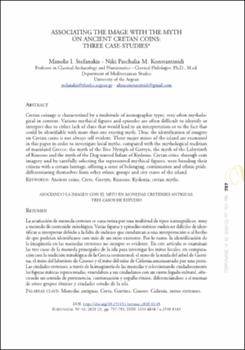Associating the image with the myth on ancient Cretan coins: Three casestudies
Fecha
2020Resumen
Cretan coinage is characterized by a multitude of iconographic types, very often mythological
in content. Various mythical figures and episodes are often difficult to identify or
interpret due to either lack of clues that would lead to an interpretation or to the fact that
could be identifiable with more than one existing myth. Thus, the identification of imagery
on Cretan coins is not always self evident. Three major mints of the island are examined
in this paper in order to investigate local myths, compared with the mythological tradition
of mainland Greece; the myth of the Tree Nymph of Gortyn, the myth of the Labyrinth
of Knossos and the myth of the Dog-nursed Infant of Kydonia. Cretan cities, through coin
imagery and by carefully selecting the represented mythical figures, were bonding their
citizens with a certain heritage, offering a sense of belonging, continuation and ethnic pride,
differentiating themselves from other ethnic groups and city states of the island. La acuñación de moneda cretense se caracteriza por una multitud de tipos iconográficos, muy
a menudo de contenido mitológico.Varias figuras y episodiosmíticos suelenser difíciles de identificar
o interpretar debido a la falta de indicios que conduzcan a una interpretación o al hecho
de que podrían identificarse con más de un mito existente. Por lo tanto, la identificación de
la imaginería en las monedas cretenses no siempre es evidente. En este artículo se examinan
las tres casas de la moneda principales de la isla para investigar los mitos locales, en comparación
con la tradición mitológica de la Grecia continental; el mito de la ninfa del árbol de Gortina,
el mito del laberinto de Cnosos y el mito del niño de Cidonia amamantado por una perra.
Las ciudades cretenses, a través de la imaginería de las monedas y seleccionando cuidadosamente
las figuras míticas representadas, vinculaban a sus ciudadanos con un cierto legado cultural, ofreciendo
un sentido de pertenencia, continuación y orgullo étnico, diferenciándose a sí mismas
de otros grupos étnicos y ciudades estado de la isla.





